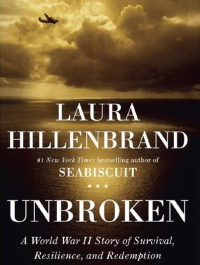 Unbroken
Unbroken
A World War II Story of Survival, Resilience and Redemption
By Laura Hillenbrand. 473 pp.
Random House, 2010. $27.
Laura Hillenbrand’s gifts for tempo, atmosphere, and empathy shaped Seabiscuit: An American Legend into a best-selling phenomenon. She made that Depression-era tale so vivid to contemporary readers that the horse and his handlers felt once again like tabloid heroes.
Since Hillenbrand has a remarkable affinity for never-say-die underdogs overcoming stiff odds and achieving miracles, Unbroken seems an almost inevitable follow-up. Its doughty protagonist is Louis Zamperini, who emerged from a delinquency-prone adolescence in Torrance, California to become a world-class runner with a penchant for strong finishes. He placed eighth in the 5,000-meter race at the 1936 Olympics in Berlin, but ran his last lap in an eye-popping 56 seconds. Zamperini was ready to do even better four years later at Tokyo’s Olympics. But then came World War II—which is where Unbroken’s story truly begins.
On May 27, 1943, Zamperini was serving as a turret gunner in his B-24, dubbed “the Green Hornet,” when it went down in the South Pacific while searching for a missing plane. Of the 11-member crew, only Zamperini and two others survived the crash; one of them, however, died after they had spent more than a month drifting in a rubber raft, living on storm water and whatever fish, even sharks, they could catch.
After 46 days at sea, Zamperini and his fellow survivor were picked up by Japanese sailors. As was the case with other American POWs in the Pacific Theater, their captivity was filled with torment and atrocity. Hillenbrand spares little detail in recounting two years of starvation, medical experiments, slave labor, and unrelenting torture. (One guard, Mutsuhiro “the Bird” Watanabe, is singled out for taking a kind of connoisseur’s pleasure in his sadistic treatment of Zamperini and his fellow captives.) Perhaps not surprisingly, the war’s aftermath offered little immediate relief to Zamperini, who went through a troubled stateside adjustment riddled with nightmares and alcoholism, before finally finding solace in religion.
This is the kind of page-turning saga that, as with Seabiscuit, practically writes itself. Unbroken, like its predecessor, will likely appear someday onscreen at a theater near you. Yet even with so many galvanic twists and turns tugging the reader along, this book feels as if it’s trying to sell, more than tell, its story—which, as it happens, has been told many times before in newspaper, magazine, and television accounts, not to mention a 2004 reprint of the protagonist’s own 1956 autobiography Devil at My Heels. The ground, though fertile, has been thoroughly plowed. Still, since Zamperini is still alive and apparently well at age 93, it’s reasonable to expect probing from a reporter with Hillenbrand’s obvious gifts to yield greater, deeper insights into his ordeal. This, after all, is what lifted Seabiscuit to well-deserved heights. Unfortunately, she’s content here to pile on the facts and let them do the work. Unbroken tells a good yarn, but it could have been more.




